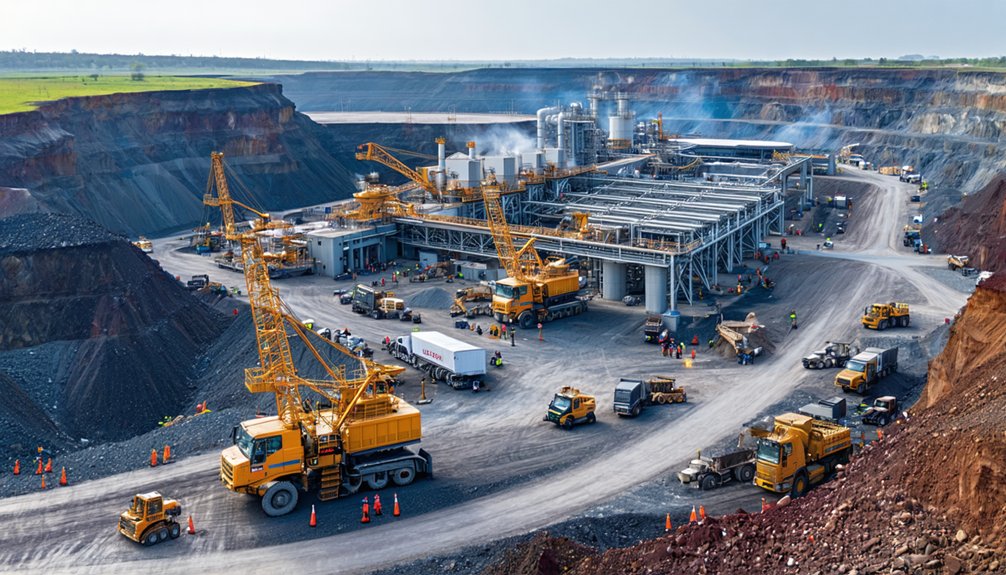Endiama, Angola’s national diamond company, has set an ambitious production target of 15.1 million carats for 2025, building on its projected 14.6 million carats for 2024. This growth is primarily driven by major operations like the Catoca mine, which contributes 75% of Angola’s diamond output, and the newly operational Luele mine. Strategic investments, including a $635 million expansion at Luele and development of the Saurimo Diamond Hub, support this path. Despite global market challenges and a 12.34% drop in natural diamond prices, Endiama maintains strong revenue projections of $2.5 billion for 2024. The company’s extensive expansion strategy reveals promising opportunities in Angola’s diamond sector.
Article Contents
- 1 Main Highlights
- 2 Current Diamond Production Landscape
- 3 Major Mines Driving Growth
- 4 Infrastructure Development and Investment
- 5 Market Impact and Revenue Outlook
- 6 Strategic Partnerships and Joint Ventures
- 7 Future Exploration and Expansion Plans
- 8 Frequently Asked Questions
- 8.1 How Does Diamond Processing Affect Local Water Resources and Environmental Sustainability?
- 8.2 What Safety Measures Are Implemented to Protect Workers in Angola’s Diamond Mines?
- 8.3 How does Angola prevent conflict diamonds from entering its supply chain?
- 8.4 What percentage of Angola’s diamond industry workforce is made up of women?
- 8.5 How Do Local Communities Benefit From Diamond Revenue Sharing Programmes?
- 9 Our Final Thoughts
Main Highlights
- Endiama aims to increase diamond production from 14.6 million carats in 2024 to 15.1 million carats by 2025.
- The Catoca mine, Angola’s largest producer, will contribute up to 75% of production with 6.9 million carats in 2024.
- Luele mine targets 3.5-4 million carats annually by 2025, supported by a $635 million investment to triple processing capacity.
- Strategic partnerships with De Beers and infrastructure development projects will help achieve the 2025 production target.
- Angola’s diamond sector expansion includes exploration of untapped territories and modernisation of mining operations to meet goals.
Current Diamond Production Landscape
The global diamond industry faces a significant production downturn, with output expected to reach a 29-year low of 105 million carats in 2024. This decline represents a stark contrast from the peak production of 153 million carats achieved in 2018, highlighting substantial diamond supply challenges across the sector.
Major producers are responding differently to current market conditions, with De Beers reducing production targets whereas Alrosa opts for stockpiling inventory. De Beers has particularly shown significant changes with Q3 output of 5.6 million carats, marking their lowest production since Q2 2020. Angola’s state diamond company Endiama aims to contribute significantly to global supply with 14.6 million carats projected for 2024.
Mining profitability concerns have intensified due to rising operational costs and declining diamond prices, prompting strategic adjustments throughout the industry. The situation is further complicated by ageing mines nearing depletion and geopolitical tensions affecting international trade. The surge in lab-grown diamonds has contributed to natural diamond prices dropping by 12.34% in April 2024.
When considering only diamonds actually sold to market, 2024’s supply could fall below 100 million carats, a level not seen since 1989.
Major Mines Driving Growth

Angola’s diamond production growth is underpinned by three major mines, with the Catoca mine retaining its position as the fourth-largest diamond mine globally, despite its significant contribution to national output.
The Luele mine‘s development holds promise for substantial growth, with projected annual production of 3.5-4 million carats by 2025, enhancing existing operations through its strategic location next to Catoca. Plans to sell 40 percent of all diamond production to local entities are in line with the country’s beneficiation strategy.
As global diamond trade dynamics evolve amidst G7 sanctions, the industry faces new challenges in sourcing and market access.
Strategic partnerships and investments in these major mines, along with the promising Luaxe project, position Angola to meet its ambitious production targets, despite recent changes in ownership structures due to EU sanctions impacting Alrosa’s involvement. The return of De Beers to Angola after a decade-long absence signals renewed confidence in the country’s diamond sector potential.
Catoca’s Steady Production Growth
Leading Angola’s diamond sector, Catoca mine has established itself as the world’s fourth-largest diamond operation, consistently delivering up to 75% of the country’s total diamond output.
Despite facing challenges during the COVID-19 pandemic, which reduced production to 2 million carats in 2020, the mine is set to demonstrate remarkable production efficiency through ambitious growth targets.
The operation, managed by Sociedade Mineira de Catoca since 1993, projects an increase to 6.9 million carats by 2024, supported by an extensive £69,282 thousand investment plan.
This expansion focuses on modernising treatment plants and equipment while emphasising workforce training. Recent market conditions have led to significant price drops of 30-55% in the first half of the year, presenting additional challenges for the sector. With the recent launch of the Luele mine and its 628 million carat reserves, Angola’s diamond production capacity is poised for substantial growth.
The mine’s strategic importance extends beyond current operations, as it plays a pivotal role in Angola’s vision to become the world’s third-largest rough diamond producer by 2027.
Luele’s Expanding Mining Operations
Located in Angola’s northeastern Lunda Sul province, Luele mine represents a significant addition to the nation’s diamond production capacity, complementing Catoca’s established operations.
The company achieved 4.4 million carats in its first operational year after being inaugurated in November 2023. The mine’s expansion plans include tripling its ore processing capacity within three years, supported by advanced mining technology and an initial investment of $635 million. The project’s strategic ownership includes Catoca Mining Society holding a majority 50.5% stake.
With estimated reserves of 628 million carats and a projected 60-year lifespan, Luele is poised to become a major force in global diamond production.
The operation currently employs 2,441 workers and aims to create 3,000 direct jobs by 2026.
Starting with an annual production of 5 million carats, the mine plans to increase output to 6 million carats annually, potentially doubling Angola’s overall diamond production.
Strategic Partnerships Boost Output
Strategic partnerships are reshaping Angola’s diamond industry, with major collaborations driving substantial growth in production capacity. The partnership between Endiama, Sodiam, and De Beers introduces new technologies for kimberlite exploration, as well as implementing sustainability initiatives and community engagement through the Building Forever framework. This strategic alignment enhances transparency and production efficiency across operations. The unexplored diamond regions, comprising 60% of Angola’s territory, present significant opportunities for future development. The agreement signed at Mining Indaba 2024 establishes a framework for promoting the development of Angola’s diamond sector. These collaborations, combined with modernised sales structures and privatisation efforts, position Angola to achieve its ambitious production targets while ensuring sustainable development and local community benefits.
| Partner | Project | Investment Focus |
|---|---|---|
| De Beers | Kimberlite Review | Technical Innovation |
| Rio Tinto | Chiri Programme | Exploration (75% stake) |
| Alrosa | Catoca Mine | Production (41% stake) |
| Sodiam | Trading Hub | Value Addition |
| Local Manufacturers | Processing | Market Development |
Infrastructure Development and Investment

Infrastructure development in Angola is accelerating with the creation of the Saurimo Diamond Hub, a 35,000-square-metre facility intended to accommodate cutting factories, offices, and training facilities near the Catoca mine.
Despite its location 600 kilometres from Luanda, the hub is strategically placed to benefit from production at both existing operations and the newly opened Luele mine, which is expected to double the nation’s diamond output. The post-war rebuilding efforts initiated in 2002 have focused on infrastructure enhancement to bolster the mining sector.
These advancements, alongside improved regulatory frameworks and international collaborations, demonstrate Angola’s determination to reinforce its standing in the global diamond market while fostering local economic development through the creation of 5,000 new jobs. With the National Development Plan now in effect, the country is set to investigate 60% of unexplored territories abundant in diamond deposits.
Mining Hub Expansion Plans
Four major infrastructure projects form the backbone of Endiama’s ambitious mining hub expansion strategy. The Catoca Mine expansion and Luele Mine development represent significant production capabilities, while the Saurimo Diamond Hub facilitates mining hub integration through its extensive facilities. The company has allocated USD 42.3 million to support geological and mining prospecting activities across its projects.
The Mulepe Diamond Deposit complements these developments with its focus on local community engagement and sustainable mining practices. The project will process 3 million tonnes of kimberlite annually through its advanced mining operations.
These projects are strategically interconnected, with the 35,000 square-metre Saurimo hub serving as a central nerve centre near the Catoca mine. The hub’s cutting factories, training school, and diamond exchange will create 5,000 jobs, whereas the Luele Mine’s projected 3.5-4 million carat annual production capacity will supply the necessary raw materials for processing and value addition within the integrated complex.
Transport Network Improvements
To support Endiama’s expanding diamond operations, extensive transport infrastructure improvements are being implemented through the Lobito Corridor initiative and associated infrastructure projects. This strategic development aims to tackle infrastructure challenges by reducing mineral transport times by up to 75% as it connects inland mines to the port of Lobito.
With annual diamond production projected to reach 17.5 million carats by 2027, these infrastructure upgrades are essential for managing increased output volumes. The company’s commitment to achieving 12 million carats in 2023 demonstrates steady progress towards long-term goals.
The improvements encompass comprehensive transport logistics solutions, including rail development, port expansion, and road haulage enhancements.
Through public-private partnerships, these initiatives are bolstering distribution networks across the territory. The integration of renewable energy infrastructure ensures sustainable operations, while broadband development supports modern logistics management.
These coordinated efforts are designed to increase the mining sector’s competitiveness and facilitate more efficient mineral movement throughout the region.
Processing Facility Development
Endiama’s ambitious processing facility expansion encompasses major infrastructure developments across multiple sites, with the Luele mine’s $500 million initial processing facility serving as the cornerstone project.
The investment includes advanced processing technology and workforce training initiatives, highlighted by the establishment of a dedicated training academy and a cutting and polishing school.
The company plans to support roughly 20,000 diamond workers through these expanded facilities and training programmes.
The Saurimo Diamond Hub represents a significant component of this development, featuring cutting factories, offices, and a diamond exchange with deep-boiling facilities.
With 26 industrial plots available and the potential to create 5,000 local jobs, the hub integrates production, processing, and training capabilities.
The facilities enable thorough diamond processing, from initial extraction through sorting and bulk selling, as the training programmes guarantee a skilled local workforce to support these operations.
Under Minister Azevedo’s guidance, the government is considering establishing tax-free zones to attract additional international investors to the facilities.
Market Impact and Revenue Outlook

Despite facing unparalleled market challenges in 2024, including a significant 40-60% decline in international diamond prices and increasing competition from lab-grown alternatives, ENDIAMA is setting ambitious revenue targets of $2.5 billion for 2024.
The recent extraction of 4.2 million carats between January and May 2024 demonstrates the company’s sustained operational capabilities despite market difficulties.
The company’s resilience is evident in its historical performance, having doubled its turnover from $1 billion in 2018 to $2 billion in 2022. Natural diamond prices have experienced a sharp downturn, with wholesale polished diamonds decreasing by about 20% in the past year.
Key market factors affecting ENDIAMA’s outlook:
- Shifting consumer preferences towards sustainable alternatives
- Global sanctions impacting Russian polished diamonds
- Lab-grown diamond market expected to double by 2025
- Supply chain disruptions affecting international trade
Despite these challenges, ENDIAMA’s production targets remain robust, with projections reaching 15.1 million carats in 2025, supported by operational enhancements and new mining projects.
Strategic Partnerships and Joint Ventures

Strategic partnerships form the backbone of ENDIAMA’s production expansion plans, enabling the company to strengthen its market position whilst navigating the challenging terrain of the diamond industry.
The joint venture advantages are clear in collaborations with industry leaders such as Alrosa at the Catoca mine and Rio Tinto’s 75% stake in the Chiri exploration programme. A significant development is the Mulepe diamond deposit partnership with Gemcorp, who will invest over $150 million and manage operations. This partnership will achieve an annual processing capacity of approximately 3 million tonnes of kimberlite. The project is expected to create employment opportunities for 140 local workers.
While partnership challenges include coordinating multiple stakeholders, ENDIAMA’s strategy of engaging reputable operators has proven effective.
The company’s planned privatisation of up to 30% through an IPO, combined with these strategic alliances, positions it to implement industry best practices and bolster production capabilities across its mining portfolio.
Future Exploration and Expansion Plans

As Angola’s diamond sector enters a groundbreaking phase, major exploration and expansion initiatives are taking shape across multiple regions.
Endiama’s expansion strategies focus on significant investments in promising projects, with exploration techniques targeting both kimberlite and alluvial deposits across the country’s diamond-rich territories.
Key development initiatives include:
- $40 million investment in Lunda-Norte province for the Uari and Luembe prospecting projects
- Development of the Luaxe mine, projected to produce 3.5-4 million carats annually by 2025
- Advancement of the Sangamina kimberlite project, requiring $250 million in investment
- Implementation of the Luachimba alluvial project, with a $30 million capital requirement
These strategic expansions align with Endiama’s goal to reach 17.5 million carats annually by 2027, positioning Angola as a major global diamond producer. The projects have created employment opportunities for 600 young Angolans in the Lunda-Norte region, contributing to local economic development.
Frequently Asked Questions
How Does Diamond Processing Affect Local Water Resources and Environmental Sustainability?
Diamond processing causes severe water pollution through chemical contamination and sediment discharge, creating lasting ecological impacts on aquatic ecosystems, compromising water quality, and threatening local communities’ water resources.
What Safety Measures Are Implemented to Protect Workers in Angola’s Diamond Mines?
Angola’s diamond mines implement extensive worker training programmes, mandatory safety equipment requirements, health monitoring systems, and standardised operating procedures to protect miners from occupational hazards and prevent workplace accidents.
How does Angola prevent conflict diamonds from entering its supply chain?
Angola implements stringent conflict prevention through KPCS certification, government-controlled mining areas, mandatory Certificates of Origin, and surveillance by ENDIAMA and the National Police to prevent illicit diamond trade.
What percentage of Angola’s diamond industry workforce is made up of women?
In a field where progress moves at a glacial pace, specific data on women’s participation in Angola’s diamond industry is unavailable, though broader patterns show limited women’s empowerment and gender equality in formal sectors.
How Do Local Communities Benefit From Diamond Revenue Sharing Programmes?
Local communities benefit through revenue allocation mechanisms that fund infrastructure, social programmes, and community development initiatives, as well as receiving economic advantages from employment opportunities and local business procurement.
Our Final Thoughts
Endiama’s ambitious projection of 15.1 million carats for 2025 represents a shining beacon for Angola’s diamond industry. Through strategic infrastructure development, technological advancement, and key partnerships, this target appears within reach. Like a carefully cut jewel revealing new facets, the company’s expansion plans showcase multiple growth vectors. This production milestone would significantly strengthen Angola’s position in global diamond markets as it boosts national economic development through increased revenue and employment opportunities.




